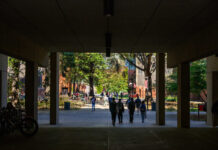The school had received few updates since it moved from Brook Street and Broadway to Preston Street in 1970.
“UofL has a mission to improve the lives of people in the Commonwealth, and this is a visible way in which we are accomplishing that goal,” said UofL President James Ramsey. “If we are to provide the education and training for the next generation of health care providers for Kentucky, we must remain on the leading edge of teaching and training practices — which requires the appropriate investment in new technology. This renovation will allow our students to have the best possible learning environment.”
Enhancements include
- updates to infrastructure, operatory equipment and clinical education support
- new digital radiography
- incorporation of an electronic health records system and state-of-the-art classroom technology improvements in patient waiting rooms and clinical space that include new chairs, lighting, cabinetry and touch-screen computer terminals
The main entrance also has moved to the east side of the building, creating a safer area for patient drop-off.
“These upgrades are critical to competing nationally for high-quality students, recruiting talented faculty and attracting patients who (both) need care and … augment the educational experience of our students,” said David Dunn, executive vice president for health affairs.
Students, said senior Caroline Curtis, “have seen and fully experienced this renovation. We had to learn patience and flexibility, and though it was long and at times arduous, like so many things — it was worth the wait.”
The changes will benefit both students and their patients, she said. For instance, the digital scanner has “an optical wand that allows us to take multiple pictures and build a three dimensional image on a computer – technology that will ultimately replace the traditional metal tray used to take an impression of the teeth.”
The improvements also will have a far-reaching effect on the school’s capacity for innovation.
“Collaboration among departments and disciplines is essential to treat and solve the complexities of oral diseases,” said Dean John Sauk. “The renovated facility will foster a practice-based research network.”
Patients also will benefit from aesthetic changes that include the display of local art near the main entrance, the first floor and the pediatric dentistry area.
“Research shows that art can ease patient anxiety,” Sauk said. “The art also enhances the beauty of our new facility.”
The school has collaborated with the Louisville Visual Arts Association, which has loaned it several local pieces to display through end of the year. It also has joined the Society for the Arts in Healthcare and hopes to integrate local art in the building on a more permanent basis.
UofL plans to seek Leadership in Energy and Environmental Design (LEED) certification from the Green Building Certification Institute. Among the green changes incorporated into the building are more efficient HVAC systems and lighting controls that reflect the building’s occupancy.


























